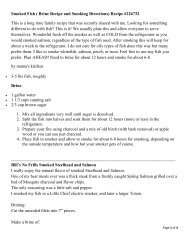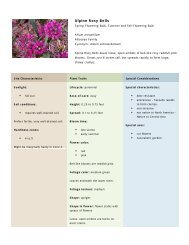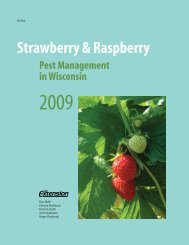Late Blight -- Irish Potato Famine Fungus -- Attacks U.S. Northeast ...
Late Blight -- Irish Potato Famine Fungus -- Attacks U.S. Northeast ...
Late Blight -- Irish Potato Famine Fungus -- Attacks U.S. Northeast ...
You also want an ePaper? Increase the reach of your titles
YUMPU automatically turns print PDFs into web optimized ePapers that Google loves.
<strong>Late</strong> <strong>Blight</strong> -- <strong>Irish</strong> <strong>Potato</strong> <strong>Famine</strong> <strong>Fungus</strong> -- <strong>Attacks</strong><br />
U.S. <strong>Northeast</strong> Gardens And Farms Hard<br />
Leaf lesions due to late blight. (Credit: Copyright<br />
College of Agriculture and Life Sciences, Cornell<br />
University)<br />
Science Daily (July 5, 2009) — Home gardeners<br />
beware: This year, late blight -- a destructive<br />
infectious disease that caused the <strong>Irish</strong> potato<br />
famine in the 1840s -- is killing tomato and potato<br />
plants in gardens and on commercial farms in the<br />
eastern United States. In addition, basil downy<br />
mildew is affecting plants in the <strong>Northeast</strong>.<br />
"<strong>Late</strong> blight has never occurred this early and this widespread in the U.S," said Meg McGrath,<br />
associate professor of plant pathology and plant-microbe biology.<br />
One of the most visible early symptoms of the disease is brown spots (lesions) on stems. They<br />
begin small and firm, then quickly enlarge, with white fungal growth developing under moist<br />
conditions that leads to a soft rot collapsing the stem.<br />
Classic symptoms are large (at least nickel-sized) olive-green to brown spots on leaves with<br />
slightly fuzzy white fungal growth on the underside when conditions have been humid (early<br />
morning or after rain). Sometimes the border of the spot is yellow or has a water-soaked<br />
appearance. Spots begin tiny, irregularly shaped and brown. Firm, brown spots develop on<br />
tomato fruit.<br />
McGrath stresses the need to act quickly to protect garden-grown tomato and potato plants and<br />
to make sure that plants don't become a source of spores that could infect commercial farms, as<br />
late blight spores are easily dispersed by wind.<br />
She recommends that gardeners:<br />
• Examine their tomato and potato plants thoroughly at least once a week for signs of late<br />
blight;<br />
• Spray fungicides preventively and regularly, and/or<br />
• Be prepared to destroy plants when late blight starts to become severe.<br />
"If you want to try to control late blight with fungicides, you need to begin spraying now --<br />
even before you see symptoms -- and you need to continue spraying regularly," said McGrath.<br />
"Use a product that contains chlorothalonil. Copper is not very effective on late blight."
Petunias, which are closely related to tomatoes and potatoes, can also be infected by late blight<br />
and show similar symptoms.<br />
<strong>Late</strong> blight is very destructive. Uncontrolled, it will kill plants faster than any other disease.<br />
And it affects tomato fruit -- especially green ones. Even with fungicide applied every week,<br />
there is no guarantee of success, especially if the rainy weather continues. McGrath<br />
recommends that gardeners consider growing more of other vegetables this year.<br />
One source of late blight in New York has been traced to tomato plants imported to garden<br />
centers from production facilities in the south. If tomatoes were started from seed by a gardener<br />
or a farmer in the <strong>Northeast</strong>, plants are unlikely to be infected, at least initially, she said. If<br />
plants were purchased at a garden center and they show signs of late blight, McGrath<br />
recommends contacting a local office of Cornell Cooperative Extension or Cornell's Plant<br />
Disease Diagnostic Clinic to get confirmation and tell them where you purchased the plants.












